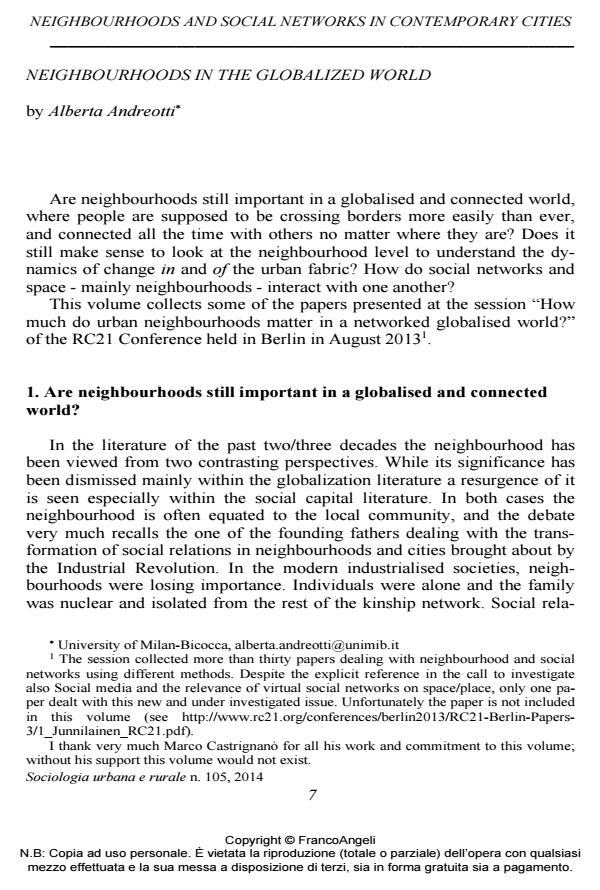Neighbourhoods in the globalized world
Titolo Rivista SOCIOLOGIA URBANA E RURALE
Autori/Curatori Alberta Andreotti
Anno di pubblicazione 2014 Fascicolo 2014/105 Lingua Inglese
Numero pagine 13 P. 7-19 Dimensione file 200 KB
DOI 10.3280/SUR2014-105001
Il DOI è il codice a barre della proprietà intellettuale: per saperne di più
clicca qui
Qui sotto puoi vedere in anteprima la prima pagina di questo articolo.
Se questo articolo ti interessa, lo puoi acquistare (e scaricare in formato pdf) seguendo le facili indicazioni per acquistare il download credit. Acquista Download Credits per scaricare questo Articolo in formato PDF

FrancoAngeli è membro della Publishers International Linking Association, Inc (PILA)associazione indipendente e non profit per facilitare (attraverso i servizi tecnologici implementati da CrossRef.org) l’accesso degli studiosi ai contenuti digitali nelle pubblicazioni professionali e scientifiche
Sono ancora rilevanti i quartieri nella vita degli individui, in un mondo in cui la mobilità diventa sempre più rilevante e si può essere connessi ovunque e con chiunque in ogni momento? Ha ancora senso guardare al quartiere per comprendere e spiegare le dinamiche di cambiamento nella e della fabbrica urbana? Come reti sociali e spazio - quartieri - interagiscono? Questa introduzione affronta questi temi a partire dai contributi presentati nel volume. Tali contributi sono stati presentati alla sessione "Quanto contano i quartieri in un mondo globale e connesso" della Conferenza Internazionale organizzata dal Research Committee 21 a Berlino nell’Agosto 2013.
Keywords:Città, quartieri, mobilità, relazioni di potere, reti sociali, famiglia.
- Alcock P. (2014). The Big Society: A New Policy Envoronment for the Third Sector? In Pierson C., Castles F.G., Nauman I.K. (eds.). The Welfare State. Cambridge: Polity Press, pp. 296-308.
- Andreotti A., Moreno Fuentes F.J., Le Galès P. (2015). Globalised Minds, Roots in the City: Urban Upper-Middle Classes in Europe. Oxford: Wiley Blackwell.
- Andreotti A., Moreno Fuentes F.J., Le Galès P. (2013). Controlling the Urban Fabric: The Complex Game of Distance and Proximity in European Upper Middle Class Residential Strategies. International Journal of Urban and Regional Research, 2: 578-597.
- Banfield E.C. (1959). The Moral Basis of a Backward Society. Glecncoe: The Free Press.
- Bauman Z. (1998). Globalization: The Human Consequences. New York: Columbia University Press.
- Beck U. (2006). The Cosmopolitan Vision. Cambridge: Polity Press.
- Blokland T., Savage M. (eds.). (2008). Networked Urbanism. Social Capital in the City. Aldershot-Burlington: Ashgate.
- Boase J., Horrigan J.B., Wellman B., Rainie L. (2006). The Strength of Internet Ties, Pew Internet & American Life Project, 202-419-4500 http://www.pewinternet.org/.
- Bridge G., Butler T., Le Galès P. (2014). Negotiation and Power Relations Between Social Groups in Global Cities: Beyond Gentrification? International Journal of Urban and Regional Research, 38: 1133-1141. DOI: 10.1111/1468-2427.1212
- Coleman J.S. (1990). Foundations of social theory. Cambridge, MA: Belknap Press of Harvard University Press.
- Friedman J. (2002). From Roots to Routes: Tropes for Trippers. Anthropological Theory, 1: 21-36. DOI: 10.1177/146349960200200128
- Giddens A. (1994). Living in a Post-Traditional Society. In: Beck U., Giddens A., Lash S. Reflexive Modernization: Politics, Tradition and Aesthetics in the Modern Social Order. Cambridge: Polity Press. pp. 56–109.
- Hannerz U. (1980). Exploring the City. Inquiries toward an Urban Anthropology. New York: Columbia University Press.
- Kennedy P. (2007). Global Transformations but Local “Bubble” Lives: Taking a Reality Check on Some Globalization Concepts. Globalizations, 2: 267-283. DOI: 10.1080/1474773070134527
- Istat (2013). Cittadini e nuove tecnologie. http://www.istat.it/it/archivio/108009
- Lash S., Urry J. (1994). Economies of Signs and Space. London: Sage.
- Mau S. (2010). Social Transnationalism. Life worlds beyond the Nation State. London: New York: Routledge.
- Neal Z. (2013). The Connected City: How Networks are Shaping the Modern Metropolis. New York: Routledge.
- Putnam R. (2007). E Pluribus Unum: Diversity and Community in the Twenty-first Century The 2006 Johan Skytte Prize Lecture’. Scandinavian Political Studies, 2: 137–174. DOI: 10.1111/j.1467-9477.2007.00176.x.AccessedAugust8,200
- Roudometof V. (2005). Transnationalism, Cosmopolitanism and Glocalization. Current Sociology, 1. DOI: 10.1177/001139210504829
- Savage M., Bagnall G., Longhurst B. (2005). Globalisation and Belonging. London: Sage.
- Sabatini F., Sarracino F. (2014). Online networks destroy social trust. Cornell University Library.
- Urry J. (2007). Mobilities. UK/Malden, MA: Polity Press Young M., Willmott P. (1957). Family and Kinship in East London. London: Institute of Community Studies.
- Van Kempen R., Wissink B. (2014). Between Places and Flows: Towards a New Agenda
- For Neighbourhood Research in an Age of Mobility. Geografiska Annaler: Series B, Human Geography, 2: 95–108. DOI: 10.1111/geob.1203
- Watt P. (2009). Living in an Oasis: Middle Class Disaffiliation and Selective Belonging in an English suburb. Environment and Planning, 12: 2874–2892. DOI: 10.1068/a4112
- Watt P., Smets P. (eds). (2014). Mobilities and Neighbourhood Belonging in Cities and Suburbs. Palgrave Macmillan.
- Wellman B. (1992). Which Types of Ties and Networks Give What Kinds of Social Support? Advances in Group Processes, 9: 207-235.
- We Are Social (2014). Social, Digital & Mobile Around the World http://www.slideshare.net/wearesocialsg/social-digital-mobile-around-the-world-january-2014
Alberta Andreotti, Neighbourhoods in the globalized world in "SOCIOLOGIA URBANA E RURALE" 105/2014, pp 7-19, DOI: 10.3280/SUR2014-105001